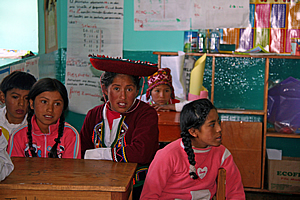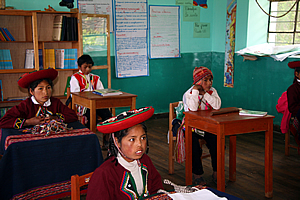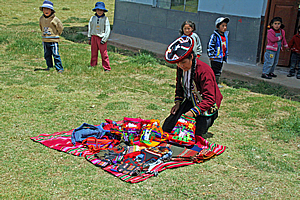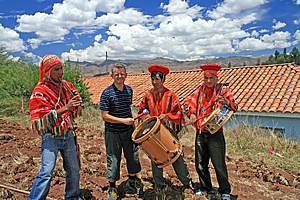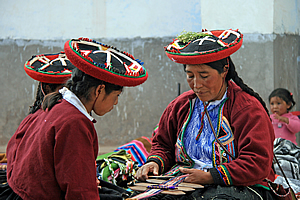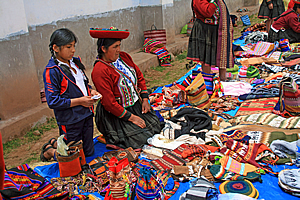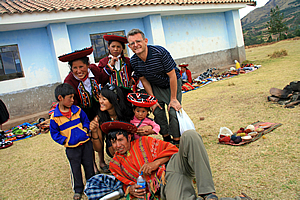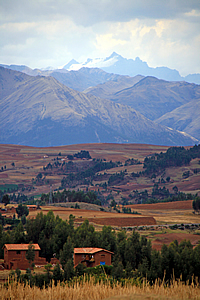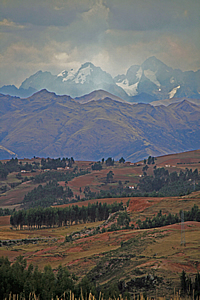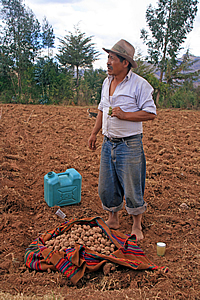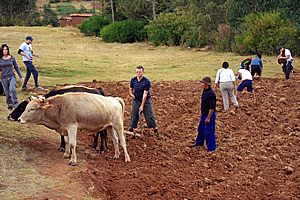--- Archive files ---
Home > Treks > Inca Trail > Day 2 > 2.2 |
Potatoes and Incan Descendants
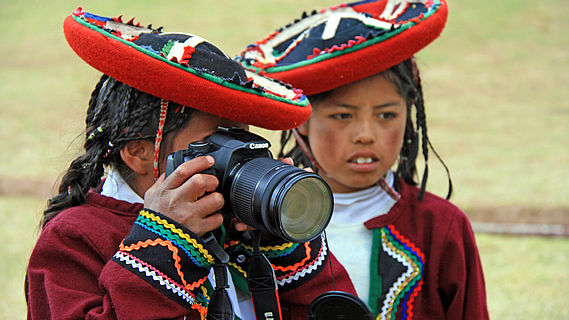
THE DRIVER parked the minibus by the side of the gravel road and walked into a school yard. One of the teachers came to meet us, and took us into her classroom. There were ten children in the classroom some dressed in the same traditional Peruvian clothing the children we had picked up were wearing. They were of different ages, but all had the deeply tanned skin and rosy cheeks expected of people living at such high altitudes. The cheeks on their triangular faces were bright red from having lived at this high altitude all their lives. The walls were painted a pastel greenish blue colour. There were numerous posters hanging around, many in Spanish, and some in the indigenous Quechuan language of the Inca. Quechua is one of the most difficult languages to learn, but it is still taught in the schools here as a means of keeping the ancient Inca culture alive despite having been overthrown by the Spaniards some five hundred years ago.
Children in classroom |
A nearby poster read (I’ll do the characters as close as possible to what was actually written):
d Llaqtay riqsitya munankitchu?
Umamarca sutiyuqmi llaqtayqo. Urqukanapa chawpinpi tarikun chakra patakunapiqa hatun sash’akuna, hatun mallkikuna winan. Sispanpi huk ch’uya mayu kan.
Challwa mayu sutiyuq. Chaypim sapa p’unchaw mayllakuyku, t’aqsakuyku ima. Umamarkaqo winachkanna; Kunanqa achka wasikunayuq, musuq nanniyoq; musuq yachay wasiwuq ima.
Children in classroom |
Chaypi tiyaqkunapus allin runa kaniku. Kaqtaqmi mayninpiqa sinchi machaq runakunapas. !Sumaqllatanam llaqtayqa winachkan! Chaymi anchata munakuni.
The children stood up and introduced themselves in their native language and performed a couple of songs for us. This would have really been something for them as we were the first tour group to visit this particular village. I wondered if they had any idea on the scale of the enormous distances we had travelled around the world to come and visit them.
Lone trader |
Once finished in the classroom, we returned outside in the bright sunshine. Led by three musicians carrying and playing their instruments, we walked around the classroom to a short trail to a large potato paddock. One of the musicians was playing a small drum, another playing a recorder-like flute, and the other was playing a large drum. On our way up we saw an old lady kneeling on a bright blue and red tartan picnic rug with numerous wares she had made for sale. We passed a small blue tap with water constantly dribbling out into a tray below. This was where the locals collected their drinking and washing water. We climbed a short steep embankment to a large potato field with raised mounds of unbroken clods running along the top.
With the musicians at the earth oven |
Here we built an oven out of clods of soil. It was essentially an igloo shape with an opening in the front where we filled it with wood, gum leaves and spuds. I had noticed a lot of Australian gum trees growing around there. They were obviously an exotic species, but they were very useful here, probably growing faster than the native species and burning better as firewood.
Once the dirt oven was loaded with wood, dried leaves and spuds, we lit a rather smoky fire. The three musicians continued playing their traditional Peruvian music as the smoke billowed out of the gaps in the oven. I had a go on the large drum.
A woman weaves |
Once the fire in the oven was well established with a good bed of embers, we returned to the green of the school yard. The children were now on a field and in front of the classroom were numerous plastic chairs laid out for us to sit on.
The musicians started playing their traditional instruments again and the children began to perform a dance. We watched them for about five minutes before one by one they came to the audience and pulled one of us out to join them. Soon we were all dancing with them – well as best as we could.
Market stall |
Once the dance was over, the children walked us hand in hand back to the gravel road where we continued to follow it for another half a kilometre up the ridge. We passed several mud brick houses under construction to a grassy park where several short and squat women of the village had large blankets laid out with numerous things they have made to sell to us. They demonstrated the spinning and weaving of the fine alpaca wool, stretching it out to a small stake about two metres away, and pulling it into wool. The ladies were all wearing the traditional red costume and hats, and the similarly dressed girls surrounded them eager to learn their craft. They showed us the natural dyes they create from native plants soils. No doubt these colours have been used here for many hundreds of years.
Group shot taken by one of the children |
We looked at all the products. I bought a new leather wallet (my old one was starting to fall apart) and a woven table runner. The wallet was intricately carved leather with Incan symbols all over it. A few of the others bought clothes and souvenirs.
Then we all posed with the children and musicians for several photos. I got a good shot of one of the young girls using Amy’s camera. The girl used mine as well to get some pictures. Looking at the pictures afterwards she obviously wasn’t very experienced at all. Hopefully after a few more tour groups come through she will be a fantastic photographer.
The Inca Trail is on the other side of these mountains |
The Inca Trail is on the other side of these mountains |
By now the sky was getting overcast with some ominous clouds forming over the mountains. I realised the weather could change very suddenly with us being at such a high altitude in amongst substantial mountains towering to over six kilometres above sea level. The musicians led us walking hand in hand with the children a bit further up the road until we reached a potato farm. There were two oxen yoked together to a small plough. Several women with large woollen bags slung over their shoulders full of seed potatoes were planting them in the furrows the oxen were digging.
Potato farmer |
The farmer gave us a demonstration on planting potatoes. He seemed very Mexican in appearance wearing a wide brimmed hat and no shoes. He told us how the potato is planted. Then he showed us some home brewed corn beer to try. It was disgusting – nothing more than rotten corn juice.
Even Luis screwed up his face when he tried it. The farmer poured some of the corn beer out of a jerry can and sprinkled it over the seed potatoes in some form of blessing ritual. We had the opportunity to help the labourers with planting potatoes.
I was fortunate in having a go at ploughing a couple of furrows with a plough drawn by two cows. I had to push the plough hard into the ground to make it penetrate properly, but it worked well once the cows were moving.
I attempt to plough the field |
Luis quickly became the camera stand. We had all given him our cameras to take photos of us. He was loaded with them. Fortunately I had my little camera with me, and I managed to get a good picture of him loaded up with all the cameras. That was an idea I had in the Amazon where I had seen him loaded up with our cameras and thought that would be such a wonderful shot. Unfortunately at the time I didn’t have my credit card camera. I made sure I had it with me today.
Once the ploughing was finished, we walked back to the school for lunch. The sky was dark and clouds were starting to envelope the mountaintops. We passed the field where we had set up the potato oven. Some women were now dismantling it, on the assumption the spuds were properly cooked by now.
<< Previous | Next >> |
|
||
About this Page
|
||
|
|
|
Where is Walkabout Jeff? |
|
|
|
|
What is happening in Walkabout Jeff's hometown?
|
|
|
|
|
Who is Walkabout Jeff?Any normal person's idea of going out involves going to the local pub for a drink with a few mates. Walkabout Jeff isn't normal.
|
|
|
|
|
